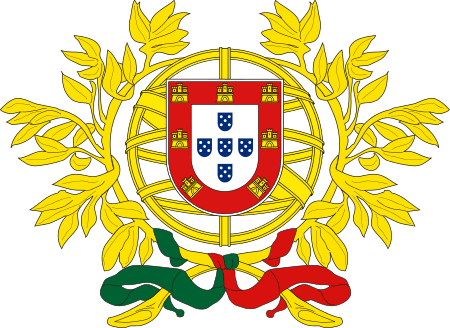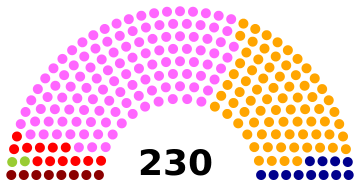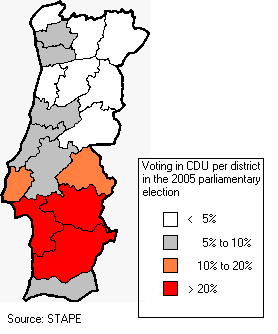Portuguese legislative election, 2005
|
| ||||||||||||||||||||||||||||||||||||||||||||||||||||||||||||||||||||||||||||||||||||||
| ||||||||||||||||||||||||||||||||||||||||||||||||||||||||||||||||||||||||||||||||||||||
230 seats to the Portuguese Assembly 116 seats needed for a majority | ||||||||||||||||||||||||||||||||||||||||||||||||||||||||||||||||||||||||||||||||||||||
|---|---|---|---|---|---|---|---|---|---|---|---|---|---|---|---|---|---|---|---|---|---|---|---|---|---|---|---|---|---|---|---|---|---|---|---|---|---|---|---|---|---|---|---|---|---|---|---|---|---|---|---|---|---|---|---|---|---|---|---|---|---|---|---|---|---|---|---|---|---|---|---|---|---|---|---|---|---|---|---|---|---|---|---|---|---|---|
| Registered |
8,944,508 | |||||||||||||||||||||||||||||||||||||||||||||||||||||||||||||||||||||||||||||||||||||
| Turnout |
5,747,834 (64.3%) | |||||||||||||||||||||||||||||||||||||||||||||||||||||||||||||||||||||||||||||||||||||
| ||||||||||||||||||||||||||||||||||||||||||||||||||||||||||||||||||||||||||||||||||||||
|
The first and the second most voted parties in each district (Azores and Madeira are not shown) | ||||||||||||||||||||||||||||||||||||||||||||||||||||||||||||||||||||||||||||||||||||||
| ||||||||||||||||||||||||||||||||||||||||||||||||||||||||||||||||||||||||||||||||||||||
 |
|---|
| This article is part of a series on the politics and government of Portugal |
| Constitution |
|
Legislature |
| Foreign relations |
The Portuguese legislative election of 2005 took place on 20 February. The election renewed all 230 members of the Assembly of the Republic.
These elections were called after the decision of President Jorge Sampaio on 30 November 2004 to dissolve the Parliament as an answer to the political instability caused by the government led by Pedro Santana Lopes (PSD) in coalition with the PP. Santana Lopes had become Prime Minister in July 2004, after José Manuel Durão Barroso left the country in order to become President of the European Commission in a decision that divided the country, because many Portuguese were expecting that the Socialist President Jorge Sampaio would dissolve the Parliament and call a legislative election. However, after five unstable months, President Sampaio decided to dissolve Parliament and call fresh elections. The Prime Minister nevertheless announced the resignation of the government on 11 December, in an action with no practical effects whatsoever.
The campaign started officially on 6 February and the major topics were the problematic state of the country's finances, unemployment, abortion and even José Sócrates's alleged homossexuality.[6][7]
Headed by Sócrates, the centre-left Socialist Party (PS) won the election with a landslide victory, winning in 19 of the 22 electoral constituencies, including in districts (such as Viseu and Bragança) that historically voted for the right. The Socialist Party conquered its first absolute majority, receiving 45% of the electorate vote and 52% of the seats in the Parliament. The centre-right parties, mainly the Social Democrats, were punished for their performance in government, and lost more than 11% of votes they had garnered in the previous election. On the left, the Left Bloc achieved its best result ever and made the biggest climb, gaining 5 MPs, while the CDU (Communists and the Greens) gained 2 MPs and reversed their downward trend of the last elections.
Voter turnout was the highest since 1995, as 64.3% of the electorate cast a ballot.
Electoral system
The Parliament of the Portuguese Republic consists of a single chamber, the Assembly of the Republic, composed of 230 members directly elected by universal adult suffrage for a maximum term of four years. Assembly members represent the entire country, rather than the constituencies in which they were elected. Governments require majority support in the Assembly in order to remain in office.
Each one of Portugal's eighteen administrative districts, as well as each one of the country's two autonomous regions - the Azores and Madeira - is an electoral constituency. Portuguese voters residing outside the national territory are grouped into two electoral constituencies - Europe and the rest of the world - each one of which elects two Assembly members. The remaining 226 seats are allocated among the national territory constituencies in proportion to their number of registered electors.
Political parties and party coalitions may present lists of candidates. The lists are closed, so electors may not choose individual candidates in or alter the order of such lists. Electors cast a ballot for a single list. The seats in each constituency are divided among parties according to the largest average method of proportional representation (PR), conceived by the Belgian mathematician Victor d'Hondt in 1899. Although there is no statutory threshold for participation in the allocation of Assembly seats, there is an effective threshold at the constituency level that depends on the district magnitude.[8] The use of the d'Hondt method makes for a higher effective threshold than certain other allocation method such as the Hare quota or Sainte-Laguë method, which are more generous to small parties.[9]
Parties
The parties that partook in the election, and their leaders, were:
- Left Bloc (BE), Francisco Louçã
- Democratic Unity Coalition (CDU), Jerónimo de Sousa
- Socialist Party (PS), José Sócrates
- Social Democratic Party (PSD), Pedro Santana Lopes
- People's Party (CDS–PP), Paulo Portas
With 230 seats the results are:
- Socialist Party (PS): 121 - Absolute Majority
- Social Democratic Party (PSD): 75
- Democratic Unity Coalition (CDU): 14
- People's Party (CDS–PP): 12
- Left Bloc (BE): 8
José Sócrates, leader of the Socialist Party, was nominated Prime Minister.
Opinion polling
National summary of votes and seats
 | ||||||||||
| Parties | Votes | % | ± | MPs | MPs %/ votes % | |||||
|---|---|---|---|---|---|---|---|---|---|---|
| 2002 | 2005 | ± | % | ± | ||||||
| Socialist | 2,588,312 | 45.03 | 96 | 121 | 52.61 | 1.17 | ||||
| Social Democratic[A] | 1,653,425 | 28.77 | 105 | 75 | 32.61 | 1.13 | ||||
| Unitary Democratic Coalition[B] | 433,369 | 7.54 | 12 | 14 | 6.09 | 0.81 | ||||
| People's | 416,415 | 7.24 | 14 | 12 | 5.22 | 0.72 | ||||
| Left Bloc | 364,971 | 6.35 | 3 | 8 | 3.48 | 0.55 | ||||
| Portuguese Workers' Communist | 48,186 | 0.84 | 0 | 0 | 0.00 | 0.0 | ||||
| New Democracy | 40,358 | 0.70 | N/A | N/A | 0 | N/A | 0.00 | N/A | 0.0 | |
| Humanist | 17,056 | 0.30 | 0 | 0 | 0.00 | 0.0 | ||||
| National Renovator | 9,374 | 0.16 | 0 | 0 | 0.00 | 0.0 | ||||
| Workers Party of Socialist Unity | 5,535 | 0.10 | 0 | 0 | 0.00 | 0.0 | ||||
| Democratic Party of the Atlantic[C] | 1,681 | 0.03 | N/A | N/A | 0 | N/A | 0.00 | N/A | 0.0 | |
| Total valid | 5,578,782 | 97.06 | 230 | 230 | 100.00 | — | ||||
| Blank ballots | 103,537 | 1.80 | ||||||||
| Invalid ballots | 65,515 | 1.14 | ||||||||
| Total (turnout 64.26%) | 5,747,834 | 100.00 | ||||||||
| A From the Social Democratic electoral lists were elected two MPs from the People's Monarchist Party and other two MPs from Earth Party. B Portuguese Communist Party (12 MPs) and "The Greens" (2 MPs) ran in coalition.[10] C Democratic Party of the Atlantic electoral list only in Azores. | ||||||||||
| Source: Comissão Nacional de Eleições | ||||||||||
Distribution by constituency
| Constituency | % | S | % | S | % | S | % | S | % | S | Total S |
|---|---|---|---|---|---|---|---|---|---|---|---|
| PS | PSD | CDU | CDS-PP | BE | |||||||
| Azores | 53.1 | 3 | 34.4 | 2 | 1.7 | - | 4.0 | - | 2.9 | - | 5 |
| Aveiro | 41.1 | 8 | 35.7 | 6 | 3.5 | - | 9.8 | 1 | 5.1 | - | 15 |
| Beja | 51.0 | 2 | 12.3 | - | 24.1 | 1 | 2.9 | - | 4.7 | - | 3 |
| Braga | 45.4 | 9 | 32.9 | 7 | 4.8 | 1 | 7.8 | 1 | 4.6 | - | 18 |
| Bragança | 42.1 | 2 | 39.0 | 2 | 2.0 | - | 9.7 | - | 2.5 | - | 4 |
| Castelo Branco | 56.0 | 4 | 26.7 | 1 | 3.8 | - | 5.3 | - | 3.7 | - | 5 |
| Coimbra | 45.4 | 6 | 31.9 | 4 | 5.5 | - | 5.5 | - | 6.3 | - | 10 |
| Évora | 49.7 | 2 | 16.7 | - | 20.9 | 1 | 3.7 | - | 4.6 | - | 3 |
| Faro | 49.3 | 6 | 24.6 | 2 | 6.9 | - | 5.8 | - | 7.7 | - | 8 |
| Guarda | 46.8 | 2 | 34.7 | 2 | 2.9 | - | 7.0 | - | 3.4 | - | 4 |
| Leiria | 35.6 | 4 | 39.8 | 5 | 4.6 | - | 8.9 | 1 | 5.5 | - | 10 |
| Lisbon | 44.1 | 23 | 23.7 | 12 | 9.8 | 5 | 8.2 | 4 | 8.8 | 4 | 48 |
| Madeira | 35.0 | 3 | 45.2 | 3 | 3.6 | - | 6.6 | - | 3.8 | - | 6 |
| Portalegre | 54.9 | 2 | 20.2 | - | 12.1 | - | 4.2 | - | 4.6 | - | 2 |
| Porto | 48.5 | 20 | 27.8 | 12 | 5.4 | 2 | 6.9 | 2 | 6.7 | 2 | 38 |
| Santarém | 46.1 | 6 | 26.4 | 3 | 8.6 | 1 | 6.9 | - | 6.5 | - | 10 |
| Setúbal | 43.6 | 8 | 16.1 | 3 | 20.0 | 3 | 5.1 | 1 | 10.3 | 2 | 17 |
| Viana do Castelo | 42.0 | 3 | 33.5 | 2 | 3.8 | - | 11.4 | 1 | 4.5 | - | 6 |
| Vila Real | 43.8 | 3 | 40.2 | 2 | 2.6 | - | 6.8 | - | 2.4 | - | 5 |
| Viseu | 40.4 | 4 | 40.2 | 4 | 2.2 | - | 8.6 | 1 | 3.3 | - | 9 |
| Europe | 54.3 | 1 | 27.2 | 1 | 4.2 | - | 3.4 | - | 2.3 | - | 2 |
| Rest of the World | 26.3 | - | 57.7 | 2 | 1.0 | - | 3.5 | - | 0.7 | - | 2 |
| Total | 45.0 | 121 | 28.8 | 75 | 7.5 | 14 | 7.2 | 12 | 6.4 | 8 | 230 |
| Source: Comissão Nacional de Eleições | |||||||||||
Maps
.png) Most voted political force by municipality.
Most voted political force by municipality. Share of vote for CDU by district.
Share of vote for CDU by district.
Graphics
 Seats won by party.
Seats won by party. Gains and losses by party.
Gains and losses by party. Share of vote by party.
Share of vote by party.
Further reading
- Freire, André; Marina Costa Lobo (May 2006). "The Portuguese 2005 legislative election: Return to the left". West European Politics. 29 (3): 581–588. doi:10.1080/01402380600620742.
References
- ↑ Assembleia da República - Deputados e Grupos Parlamentares
- ↑ Assembleia da República - Deputados e Grupos Parlamentares
- ↑ Assembleia da República - Deputados e Grupos Parlamentares
- ↑ Assembleia da República - Deputados e Grupos Parlamentares
- ↑ Assembleia da República - Deputados e Grupos Parlamentares
- ↑ Santos Costa, Filipe (2 February 2005). "Santana nega ter feito insinuações" [Santana denies having made insinuations]. Diário de Notícias (in Portuguese). Retrieved 8 June 2016.
- ↑ Paixão, Paulo (23 September 2009). "Temas que marcaram a campanha das legislativas de 2005" [Themes that marked the 2005 election campaign]. Expresso (in Portuguese). Retrieved 8 June 2016.
- ↑ "Effective threshold in electoral systems". Trinity College, Dublin. Retrieved 2015-10-21.
- ↑ Gallaher, Michael (1992). "Comparing Proportional Representation Electoral Systems: Quotas, Thresholds, Paradoxes and Majorities"
- ↑ Electoral results - Assembly of the Republic
.jpg)

.jpg)
.jpg)
.jpg)